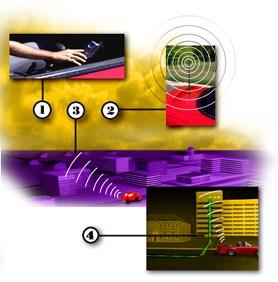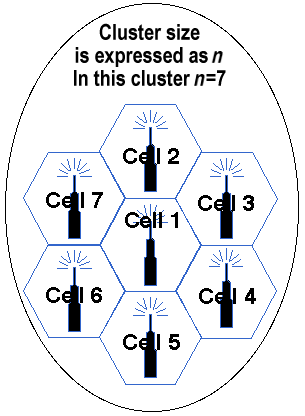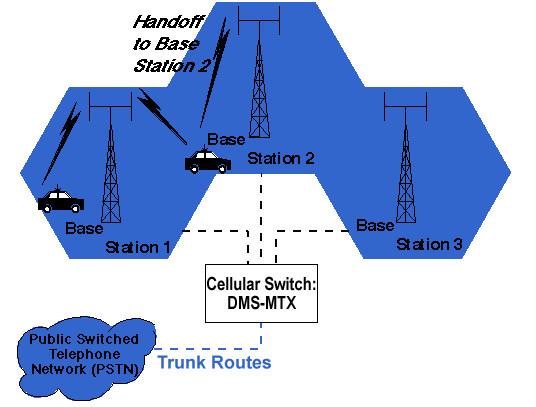
Everybody is familiar with wireless communication in some form, whether the introduction has been from the recent cellular phone revolution or perhaps from more conventional forms of communication, such as walkie talkies. Communication is no longer confined to wired links. In the past few years, there have been great developments for dialog transmission via wireless mechanisms. The key in wireless communication is to create a virtual link over the air medium such that communication between two parties occurs as if they are connected through a physical wire.
Wireless refers to a system of communications, monitoring, or control system in which electromagnetic or acoustic waves carry a signal through atmospheric space rather than along a wire. Common examples of wireless equipment in use today includes the Global Positioning System (GPS), cellular phones and pagers, remote garage-door openers, and two-way radios. In this project, we will discuss CELLULAR PHONES, their technologies, different services, and innovations geared towards global communication.
The basic transmission mechanism of the cellular telephone is very simple.
When a cellular phone is turned on, it scans a group of control channels
to determine which is the strongest base station channel. These control
channels are used only in setting up the call and moving it into an unused
channel. When the call is placed (1), a signal is transmitted
to the base station (3). The mobile switching center (MSC) sends
out the request to all the base stations that make up the cellular system.
The mobile identification number (MIN), which is the user's phone number,
is then broadcast as a paging message to the forward control channels throughout
the cellular system. The cellular phone receives the message and
identifies itself through a reverse control channel. The base
station then informs the MSC of the confirmation of the call, and then
the MSC proceeds to instruct the base station to move the call to an unused
channel (4). All this process happens within a matter of seconds,
which are not noticed by the users. The following diagram summarizes
the call transmission.

A cellular phone is a type of short-wave analog or digital transmission
mechanism in which a user has a wireless connection from a mobile telephone
to a relatively nearby transmitter. The area of coverage of the transmitter
is called a cell. The cell is also known as the basic geographic
unit of the cellular system. The term "cellular" comes from
the honeycomb shape of the areas into which a coverage region is divided.
Cells are base stations transmitting over small geographic areas that are
recognized as hexagons. The true shape of the cells is not
a perfect hexagon due to natural and man-made constraints.
A group of cells is known as a cluster. All the channels in the cluster
are never reused. The following figure shows a cluster made up seven
cells.

The main problem with the development of the cellular network was
when a mobile user traveled from one cell to another during a call.
Since adjacent areas did not use the same radio channels, calls had to
be dropped or transferred to another radio channel. Due to
this limitation in the coverage area of cellular phones, the handoff concept
was developed. Handoff occurs when when the mobile telephone network
automatically transmits a call from one radio channel to another radio
channel as the user moves between cells. When the mobile unit
moves out of the coverage area of a certain cell, its reception becomes
weak. At that point, the cell being used by the phone requests
a handoff. The system transfers the call to a channel with
a stronger frequency in a new cell site without interrupting the call or
letting the user know. The call may continue as the user moves
between different coverage areas, and the handoff is unnoticeable.
The handoff process is illustrated in the diagram below:

The cellular telephone service is usually available in urban areas and major highways. When the user moves to another area of coverage, the telephone is effectively passed on to the local cell transmitter. Cell sites are now located in just about every populated area of the country, allowing cellular telephones to be used in any major city within the United States and Canada, and all around the rest of the world.
There are two types of cellular technologies in use today: analog and digital. Analog systems have been used longer and more extensively in the past few years. Presently, most efforts in the industry are geared towards the development of digital phone networks. Such networks provide users with advanced services and features. Digital cellular phones in the future will have practically endless uses, such uses include Internet browsing, LAN access, global communication, etc. Both, analog and digital, phone systems are popular around the world and experts believe that analog systems will always be around for a long time.
One concern that users have is that firms in the digital cellular industry do not have standardized technologies. Some networks are based on CDMA (code-division multiple access) transmission technology, while other networks use TDMA (time division multiple access) technology. GSM technology is the most popular digital technology in the world. The use of digital cellular phones is likely to increase significantly as networks get standardized. These phones will be able to keep up with technology trends in other areas of communication, such as the Internet.
The future of cellular communication will be based primarily on digital
networks. However, there are other communication technologies being
developed that are designed to allow users to have global communication.
This means that some cellular subscribers will be able to use their phone
everywhere they go. Communication will certainly be GLOBAL with the
development of cellular systems that use satellites as their transmission
mechanisms. Iridium and Globalstar are examples of a
satellite network communication systems. Global communication systems
will allow people to spend more time away from their offices and have the
power of being connected at all times.

A Brief History of Cellular
Cellular Background
1921
The earliest significant use
of mobile radio takes place in the Detroit Michigan Police Department.
Their system used a channel with a frequency of 2 MHz. The channels
soon became overcrowded.
1940
New frequencies become available
at 30 and 40 MHz. Police departments across the country start to
buildup substantial radio systems. Other individuals get involved
in radio communications. Private individuals, companies, and public
agencies acquire their own mobile systems.
1945
The first public mobile telephone
system in the U.S. was developed in Missouri and it contained three channels
at 150 MHz. This mobile equipment suffered from interference.
1947
A public mobile system at frequencies
in the 35 to 44 MHz band began to be used along the highway between New
York and Boston. These frequencies were meant to allow for
greater distance communication, but interference was still a problem.
This mobile system used push to talk operation.
1949
The Federal Communications Commission
(FCC) provided individual radio channels for carrier entities called Radio
Common Carriers (ROC). The function of such companies was to interconnect
to the public telephone network to provide mobile telephone services.
1955
The number of wire line channels
at the 150 MHz band was expanded from 5 to 11.
1956
New wire line channels were
developed at 450 MHz. At this point, all calls made from or to a
mobile phone were made through an operator.
1964
A new system that operated at
a frequency of 150 MHz was developed. This system eliminated the
need for push-to-talk phones and also allowed individuals to dial their
calls.
1969
The automatic system developed
in 1964 was expanded to the 450 MHz band. The "Improved Mobile Telephone
System" (IMTS) became the widely used mobile telephone service in the U.S.
Advanced Systems (Cellular Concept)
1953
AT&T proposed the FCC to
operate a broad band mobile telephone system in the 800 MHz band.
1970
FCC announced the possible creation
of the 800 MHz band region and encouraged telecommunications firms to submit
proposals that demonstrated feasibility.
1971
AT&T proposes a feasible
cellular system and how it might be composed. No other systems
were proposed.
1974
FCC authorizes 40 MHz to be
used for mobile telephone service and requested applications for the development
of the cellular system. The Western Electric, a division of
Bell Systems, applies for authorization to make network equipment and cellular
terminal equipment. The FCC denies this request arguing that this
would create a monopoly in this new filed of communications.
1975
AT&T files a petition to
install a developmental cellular system in Chicago.
1977
The license was granted to AT&T
in March. Bell telephone constructs and operates the cellular systems.
1978
The equipment and service test
phase started. The system served 2000 trial customers. Mobile
sets were given by three suppliers.
1981
FCC issues standard regulations
for the new mobile phone industry. Between 1974 and 1981, AT&T
Bell labs worked with other equipment producers to develop cellular phones
that could be used in the cellular network.
From the 1980s, new technologies
have been developed for the use of cellular phones. Network providers
have increased significantly, as well as telephone producers.
Cellular phone service has shifted from analog signals to digital in the
last few years. The differences between the two types of signals
are covered later on.